Written work, Due Tuesday, October 23, in class:
Chapter 4 p.100: 4, 5, 10, 11
Chapter 5 p.110: 1, 4, 9
Odd problems are worth 4 points, even problems worth 8 points.
WeBWorK – none
OpenLab – none
Written work, Due Tuesday, October 23, in class:
Chapter 4 p.100: 4, 5, 10, 11
Chapter 5 p.110: 1, 4, 9
Odd problems are worth 4 points, even problems worth 8 points.
WeBWorK – none
OpenLab – none
Group Activity (25 min). Get into your groups (group assignments appear below), arrange your chairs in a circle, and take 25 minutes to:
1. Share your responses to OpenLab #4. Compare your answers to the given examples (do you all agree on the solutions?). Now share your own puzzles with the group, and discuss.
2. Create three new puzzles, as tricky as possible (try to stump Prof. Reitz!).
Group work due after 25 minutes: Each group will hand in a sheet of paper with the names of the groups members, the date, and the three new puzzles created by the group. You do not need to submit solutions, but you do need to be able to solve the puzzles on request.
Reflection: To be completed individually after group work is complete, and submitted on paper with your name and the date. Take 5 minutes to write on the following prompt:
Briefly reflect on the process of working in a group by responding to each of these points:
1. Describe something you learned.
2. Describe something you contributed to the group.
3. How did today’s work change your understanding of your assigned game?
Group 1: Federico, Samantha, Jaroslav, Yvan
Group 2: Jess, Young, Rachel, Alex
Group 3: Danping, Franklin, Silvana, Jessie
UPDATE: In order to keep pace with our Semester Project, OpenLab #5 will be assigned on Thursday 10/11 and due next week Thursday 10/18.
Written work, Due Tuesday, October 16th, in class:
Chapter 4 p.100: 1, 6, 7, 15, 16
Odd problems are worth 4 points, even problems worth 8 points.
WeBWorK – none
OpenLab – OpenLab #5. NOTE: Please complete the writing portion on the OpenLab, but bring your Conjecture to class on 10/18 (do not post your Conjecture to the OpenLab)
The assignment below is due BEFORE CLASS on Thursday, October 11th (it is essential that you complete it before class, as we will be doing a class activity building on the assignment).
We are going to play a game creating walking tours of cities with bridges. We begin in the city of King’s Mountain, which is built on four land masses – both shores of a river and two islands in midstream – connected by a total of seven bridges (shown in green).

EXAMPLE 1: Can you create a walking tour of the city that crosses every bridge exactly once? You can begin anywhere you like, and end anywhere you like, as long as you cross each bridge just once.
We can simplify the picture of King’s Mountain to make it easier to deal with:
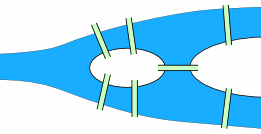
The key elements of the map are the four land masses (let’s label them A, B, C, and D) and the seven bridges (p,q,r,s,t,u and v) (thanks to mathisfun.com for the images):
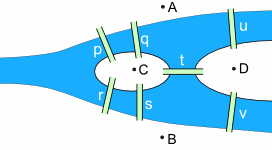
For the purposes of our problem, we can simply think about each land mass as a point (A, B, C, and D), and the bridges as lines connecting the points (p,q,r,s,t,u and v) – like this:
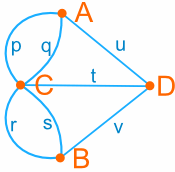
We call this kind of picture a graph – the points are called vertices and the the lines are called edges. Our goal of finding “a walking tour that crosses each bridge once” is now matter of tracing out all the edges without lifting our pencil (and without repeating any edge).
Warm up (This Warm Up is just for practice – you do NOT need to submit your answers – see below for the three-part Assignment to be submitted). The following examples build on the example above.
EXAMPLE 2: If you are given the freedom to build one new bridge in King’s Mountain (“make one new edge in the graph”), can you do it in such a way the walking tour becomes possible? Do it!
EXAMPLE 3: If you are given the freedom to destroy one bridge (“erase one edge”), can you do it in such a way that the walking tour becomes possible? Do it!
EXAMPLE 4: Construct walking tours for each of the following graphs (or decide if it is impossible).
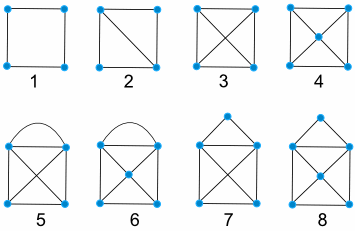
Assignment. Your assignment has 4 parts.
PART 1. For each of the four graphs below (G1 – G4), decide whether it is possible to create a walking tour crossing each bridge exactly once. Post your solutions here (TO POST A SOLUTION, JUST LIST THE POINTS OF YOUR WALKING TOUR IN ORDER). If it is not possible to create a create a solution, say so!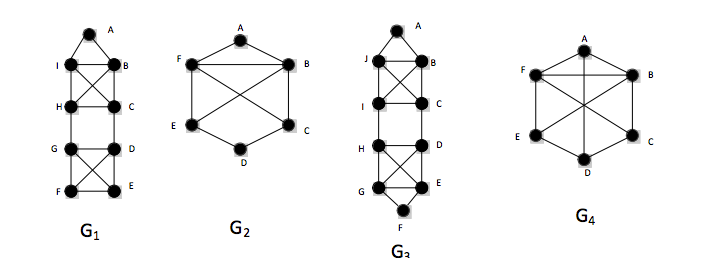
PART 2. Challenge your friends: Now it’s up to you to build your own graph, and challenge your classmates to construct a walking tour (or to determine if it is impossible). It can consist of as many points as you wish, and as many bridges (edges) connecting them. You MUST label your points “A, B, C…” etc. When you’re finished, decide for yourself if a walking tour crossing each bridge exactly once is possible. Remember, the most challenging puzzles are the ones where the answer is difficult to determine. Post two puzzles in the comments. See the note “POSTING YOUR PUZZLE ONLINE” below for instructions on how to draw and share graphs online.
PART 3. Solve a friend’s puzzle. Leave a response to a friend’s posted puzzle, giving a solution. TO POST A SOLUTION, JUST LIST THE POINTS OF YOUR WALKING TOUR IN ORDER.
Example:
Here is a puzzle: http://sketchtoy.com/67467551
Here is a solution: (start at A) – A, B, D, A, E, B, C, E
PART 4. The third part of your assignment is to write a short paragraph (at least 3 sentences) responding to the following prompt. Be sure to respond to each part:
Writing Prompt: Did you enjoy this assignment? Why or why not? Describe a connection between this assignment and our work in the class. (If you don’t believe there is a connection, try to imagine why we are doing this). Leave your response in the comments.
POSTING YOUR PUZZLE ONLINE. I recommend the site sketchtoy.com – it allows you to draw something, then click “SAVE” and get a link to your drawing. You can post the link in a comment, and we’ll be able to click on it and view your drawing. Don’t worry if it’s not pretty! For example, here is a graph that I drew (can you find a walking tour that crosses all edges?): http://sketchtoy.com/67467556
Written work – None.
WeBWorK – Assignment #5, due Tuesday, October 9th, at midnight.
OpenLab – OpenLab #4, due Thursday, October 11th, before class.
Week 5 Assignments
Exam #1 will take place on Tuesday, 10/2 (first half of class).
Written work – none
WeBWorK – Assignment #4, due Tuesday, October 2nd, at midnight. You are encouraged to start working on Assignment #5, which will be due one week later.
OpenLab – none
Week 4 Assignments
Written work – none
WeBWorK – Assignment #3, due Tuesday, September 25th, at midnight.
OpenLab – none
STUDY – for your first exam, taking place on Tuesday, 10/2, during the first hour of class. A review sheet will be posted at least 1 week prior to the exam.
Week 3 Assignments
Written work – None
WeBWorK – Start on WeBWorK 3, (it will not be due until Tuesday, 9/25 at midnight).
OpenLab – OpenLab #3, due Tuesday, 9/20 (at start of class).
NOTE: Next week Tuesday 9/18 there are no classes.
This assignment is due Thursday, September 13, at the start of class.
Assignment. Choose ONE of the following two topics. Write a reply to this post, responding to the topic. Begin by telling us which topic you chose. (1-2 paragraphs).
Topics.
Extra Credit. For extra credit, write a response to one of your classmates’ comments. Do you feel the same, or different? Did you learn anything? Did you get any ideas about teaching, or about learning?
Why are we doing this, anyway? We are following two ideas that have come up already in class — things that may not seem related to learning math, but research shows that engaging in these activities can dramatically increase the amount that you learn, and change the way you learn it. The first is writing – something not typically associated with mathematics. When you express your ideas in words, it forces you to think them through very carefully, detail by detail. A great way to check and see if you really understand something is to try to explain it to someone else, either out loud or in writing. Example: if you know how to add fractions, try teaching it someone who doesn’t know how. The second is called metacognition, or “thinking about thinking.” This happens when you think about what was going on in your head while you were working on a problem or trying to learn a new idea. What train of thought did you follow? Where did you get stuck, and what did you do next? What were you feeling at the time? and so on. Combining writing and metacognition can be a tremendously powerful tool in identifying the ways we learn best and the ways we make mistakes, and learning to improve. However, like any skill, it takes practice. That’s why we’re getting started by writing a little about our past experiences with mathematics.
Week 2 Assignments
Because we do not have class on Tuesday, September 11th, all assignments will be due on Thursday, September 13th, this week.
Written work – Sec 1.8 p.28: 3, 5, 6, 8, Due Thursday, September 13th, at the start of class.
NOTE: On this assignment, odd problems are worth 3 points, even problems worth 5 points.
WeBWorK – Assignment #2, dueThursday, September 13th, at midnight.
OpenLab – OpenLab #2, dueThursday, September 13th, at the start of class.
© 2024 2018 Fall – MAT 2071 Proofs and Logic – Reitz
Theme by Anders Noren — Up ↑
Recent Comments